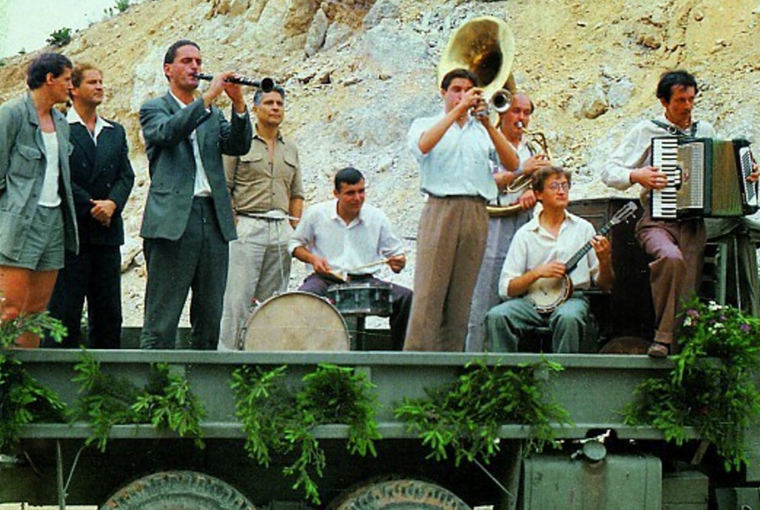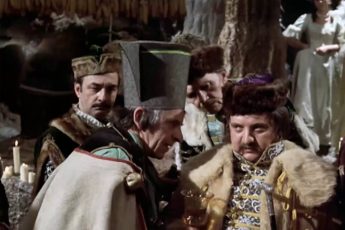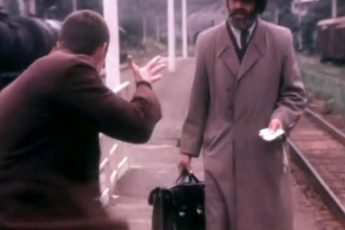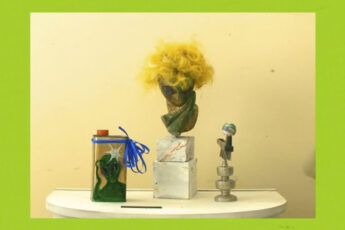Red Boogie or What’s wrong with YU
Karpo Godina’s Red Boogie (Rdeci boogie ali Kaj ti je deklica, 1982)
Vol. 36 (December 2013) by Vedrana Madžar and Zorka Obrenić
Karpo Godina’s second feature film was produced by ‘Viba film’, a very renowned production company from Ljubljana at the time, as was his first feature Splav Meduze (The Raft of the Medusa, 1980). An already established ‘complete author’ of his movies, he was not just the director of this film, but also its editor. Godina used to be the cinematographer of his own films as well, but in Rdeči Boogie ali Kak ti je Deklica (Red Boogie, 1982) he shares the credit with Vilko Filač, the frequent cinematographer of Emir Kusturica (Sjećaš li se Dolly Bell [Do you remember Dolly Bell, 1981], Dom za vsešanje [Time of the Gypsies, 1988], Arizona Dream, Underground, 1995). While the script of Splav Meduze was written by (probably) the most important and prolific writer of the so-called ‘Black Wave’ or “New Yugoslav Film”, Branko Vučićević, Godina shot Rdeči Boogie based on a script by Branko Šömen, who had already achieved considerable success as a screenwriter of Poslednja Postaja (The last station, 1971) directed by Jože Babič, Živojin Pavlović’s Let Mrtve Price (The flight of a dead bird, 1973) and Bele Trave (White grass, 1976) by Boštjan Hladnik).
Rdeči Boogie emerged only a year after the events that had seriously shaken the sociopolitical situation in socialist Yugoslavia and the mass demonstrations in Kosovo, and in the same year when radical austerity measures were adopted. Namely, in 1982, the Yugoslav dinar had been seriously devalued, the annual inflation in Yugoslavia had reached frightening 30% and the country’s debt in this period was estimated at around 20 billion dollars. However, Rdeči Boogie does not treat these sociopolitical and economic circumstances but rather the turbulent year of 1948, remembered for Tito’s famous “No!” to Stalin, the separation of Tito’s and Stalin’s policy and the split between the Yugoslav and Soviet communist path. In 1948, the implementation of the idea of the unique path of new socialist Yugoslavia started, which along with many upheavals in the end, brought fundamental changes to sociopolitical life, as well as to art, before finally birthing a new economic mechanism – self-managed socialism. The search for an autonomous political and economic model then led to a collision of ideologies and the penetration of American cultural achievements in the Yugoslav territory, where Stalin’s personality cult was still strongly present. It is this phenomenon of the Americanization of the socialist society that played a key role in the political profiling of Yugoslavia and the construction of its political status as a country that stands between the West and the East. It is clear that the process of forming a new Yugoslav reality in the context of the early Cold War propaganda could not be painless and Rdeči Boogie addresses this precise time.
A local radio station is sending a group of musicians to the countryside with the clear mission to raise the morale of the working people at the co-operatives, work brigades, construction sites and agricultural fields. This group of musicians is however seriously ‘infected’ by the (at the time) ideologically controversial jazz music and they perform this task under the strict supervision of the party Apparatchik Jan who tries to prevent the Americanization of the Yugoslav reality and to ensure that they are playing only exquisite, politically suitable music that raises the socialist morality. Jan also introduces a visual addition to their musical repertoire – the then-very-popular newsreels that had an informative as well as a propagandistic function and which reported about working efforts and achievements of Yugoslav shock-workers in the process of rebuilding the war-torn country, but also demonstrated the ways in which the society and state leadership were paying shock-workers back. The key dramatic conflict is therefore based on the clash of youth ideals, where jazz functions as a metaphor for freedom, and ideological, dogmatic intemperance. Karpo Godina approaches this conflict in a tragicomic way, strongly ironizing the fears of an invasion by American cultural values and demonstrating the absurdity and paranoia generated through a desired balance between the policy of East and West. The key sequence that illustrates this is certainly the one in which a group of musicians gives moral support and help to the people working to find and exterminate insects of American origin in Slovenia’s farming fields, which clearly implies that not only culture (and politics) are endangered by the American (cultural) legacy – but also agriculture.
Although this sequence certainly is a powerful satire, Godina does not allow it to drag the film into the grotesque but quite convincingly continues to reconstruct this specific period and, doing so, primarily focuses on painting the atmosphere more than on plot development. On the level of the script, perhaps, one could criticize the narrative-dramaturgical and character-psychological arbitrariness of Rdeči Boogie, as well as the lack of narrative motivation, but it seems that Godina did not intend to have a plot-based film at all. He actually creates a situation-based film of atmosphere and that’s exactly where he makes the point unmistakably clear – through an atmospheric painting of the period, establishing himself all over again as a director-master of photography, creating a stylistically and (in terms of ambiance) impressive piece of very refined expression.
A certain dramaturgical incoherence and narrative arbitrariness in Rdeči Boogie could be interpreted as a reflection of the stylistic continuity in the entire opus of Karpo Godina. Namely, already in the context of the ‘New Yugoslav Film’ and with his earlier films, he separated himself from the dominant current of filmmakers who, despite the variety of styles and aesthetic approaches they developed, shared a common tendency towards a predominantly realistic representation of the Yugoslav social reality. The experiments that he developed in the form of his short films, by reexamining the boundaries of the film medium, have opened a space for an association of the avant-garde on the level of content and unconventional creation of meaning. Rdeči Boogie retains something of this tradition, but here it is primarily transferred to a narrative style, while formal interventions, characteristic for his short films, are lacking. The assimilation of a typical form and aesthetics in the diegesis is one of the most noticeable differences between the short and the feature films of Karpo Godina. In movies like Zdravi Ljudi za Razonodu (Healthy People for Fun, 1971) he affronts the ethnic motives of the Yugoslav society with a modern soundtrack by the Vranešević brothers positioning the Yugoslav culture into a wider context. Ideological struggles in the field of culture are established as one of the most important topoi of Godina’s creation, and he continues to deal with them in Rdeči Boogie, but, this time, they are explicitly placed into the plot which makes them an integral element of the film narrative.
It is important here to look back to the historical relevance of the film as well, since it allows us a view of Godina’s ethical position as a creator. Jazz was a tradition in Yugoslavia even before the end of the Second World War. The first jazz orchestras were founded in Croatia in the mid-1920s of the last century, and in the mid-1930s they were fully expanded in all major centers of Yugoslavia. A jazz club was also founded in Slovenia at the very beginning of the Second Word War and, along with everyday business, functioned as a cover activity for the actions of the Liberation Front (Osvobodilna fronta). Finally the liberation of Belgrade in 1944 was celebrated with the sounds of jazz music: the screening of Sun Valley Serenade (1941) directed by H. Bruce Humberstone. The Sovietization of culture started immediately after the war and jazz as an ‘American product’ was disqualified, very well illustrated by the words of Milovan Đilas, a Yugoslav politician and writer: “America is our sworn enemy, and jazz as its product as well.”1 Already with Splav Meduze and later on with Rdeči Boogie, Karpo Godina proved to be a director who does not treat the past in a historiographic or chronological manner, but as an author treating the past primarily – politically. Likewise, he does not see art as a sort of isolated area of existence but as the core of the political.
Through the processes of broaching the issue of different roles of art in capitalism and socialism (entertainment/showbiz/hedonism vs. Agitprop art, etc.), he raises a very important question – the question of the relationship of art and labour in general. In a certain way, Rdeči Boogie is also a film about the universality of labour. Namely, Godina’s musicians (artists) in Rdeči Boogie are presented as workers: they are engaged with clear tasks, placed at certain vacancies, positioned in specific frameworks and are expected to work and to be productive. Finally, in the last scene of the film, when one of the musicians, broken and disappointed, refuses to work further with the words: “I do not want to play anymore, I do not want to motivate anybody, and I’m not gonna serve any regime anymore”, Godina ‘allows him’ to ‘leave’ the narrative of Rdeči Boogie and ‘place himself’ in the black-and-white propaganda newsreel where he, together with other Yugoslav shock-workers, finally gets a vacation on the sea, as an equally meritorious (shock-)worker. There is one more important aspect here: this black-and-white propaganda newsreel is of course part of Rdeči Boogie, but until that moment, it functions as a so-called “film-within-a-film”. In the moment when this character enters the narrative structure of the “film-within-a-film”, the boundary between it and the film is erased, and Rdeči Boogie actually ends as a propaganda newsreel.
One of the theses of Splav Meduze, namely “If an artist doesn’t want to stand still, he must advertise either industry or revolution” thereby can also be read in Red Boogie and certainly isn’t less current today. Whatever Karpo Godina advertised: industry, revolution, or both – one thing is certain – he came a long way.




Leave a Comment